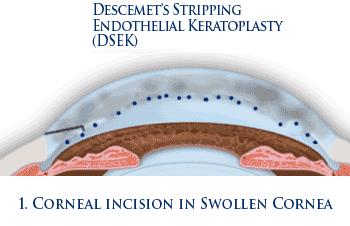DSEK
Historically, full-thickness corneal transplant surgery has not changed significantly in the last 30 years. A conventional corneal transplant requires multiple sutures and a lengthy post-operative recovery period, sometimes upwards of 12 months for patients to enjoy good-stable vision.
DSEK involves replacing just the damaged inner cell layer of the damaged cornea, rather than replacing the whole thickness of the cornea. The basic DSEK technique consists of gently stripping off the diseased cell layer lining the inner surface of the cornea. A donor cornea is thinly sliced and the inner portion is folded in half for insertion through a small incision made in the white part of the eye. The doctor injects an air bubble into the eye to unfold the donor tissue and press it up into place. The natural pumping action of the donor endothelial cells quickly creates suction, which bonds the donor tissue to the recipient cornea. This requires only a few sutures and several weeks for good recovery of vision. The results are a smoother corneal surface with increased speed of healing, as compared to a traditional full-thickness corneal transplant.
Benefits of DSEK
- Stronger corneal integrity with less sutures
- Faster recovery and rehabilitation
- Reduced chance of corneal graft rejection
- Much improved vision: several weeks rather than several months
DSEK is specifically suited for patients who have posterior corneal diseases with endothelial dysfunction. Patients with corneal conditions such as Fuch’s dystrophy, bullous keratopathy or failed prior corneal transplants are surgical candidates who may benefit from the DSEK technique.




